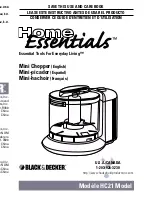
M U X L I C E R
R E F E R E N C E
F U N C T I O N A L
B L O C K S
U S E R M A N U A L
D I G I TA L S T E P C O N T R O L L E R
ADDRESS KN OB/CV I N
Address CV IN and its associated manual control "Address Knob" sets the active step
either via voltage or manually. At 0v or Run position, the module plays the entire
sequence from step 1 to 8 but when they are in other value than 0 Muxlicer will jump to a
step relative to the sum of both parameters.
It works on a synchronous way, so it only will works during playback, and will always wait
for the next clock pulse to react.
With the Address knob top anticlockwise, CV ranges goes from 0 to 1 0v. With the pot at
the middle CVs go from -5v to 5v, and with the knob top clockwise -1 0v to 0v will be
accepted. Other voltages are just ignored and don't represent any danger for the module.
The address knob move the count from 1 to 8 (clockwise). The address CV moves each step
in an equally voltage/step relation
. Voltages above the maximum are just ignored.
5v CV in is also possible changing the CV range switch (The small switch from the back of
the module).
.2
You can use this Input to create random sequences or
uniques ways of counting. Just send any complex CV
signal to Address IN and watch the sequence. During
playback Muxlicer always rising edge so you can try
any signal (even audio rates) because you will be
allways on sync.
PLAY SWI TCH
Play Switch is momentary and have two positions (up click and down click):
Down click.
Have dual
function. It Works as
“Manual Reset
” during
playback and as
“One Shot
Play”
during stop. Manual
reset will return the count to
the step 1 regardless of any
other parameter. One shot
play will start the count, and
stop always at step 8. A
down click before One Shot
play will reset the count to
the step one.
Up Click
. Works as
“Start/Stop”
. One click and
Muxlicer will start the count
from left to right, beginning
always from the step 1 .
With a second up click, it
stops at the current position.
(During playback or One Shot
play)
All manuals and user guides at all-guides.com



























